
19 Best Marketing Techniques To Grow Your Business In 2025
Are you wondering if you’ve chosen the proper marketing tools to increase brand awareness and win new customers for your business? Worry not!
This guide will help you find the best marketing techniques to boost your revenue. Most of them belong in the digital marketing field, and you can implement them even with a low budget.
We don’t expect you to adopt all of them simultaneously, especially if you’re a startup or small business. Find those that make more sense based on your current resources and business needs to kick off your marketing efforts.
Moreover, you’ll learn how to streamline these techniques effectively to bring the best possible results. Let’s start from scratch!
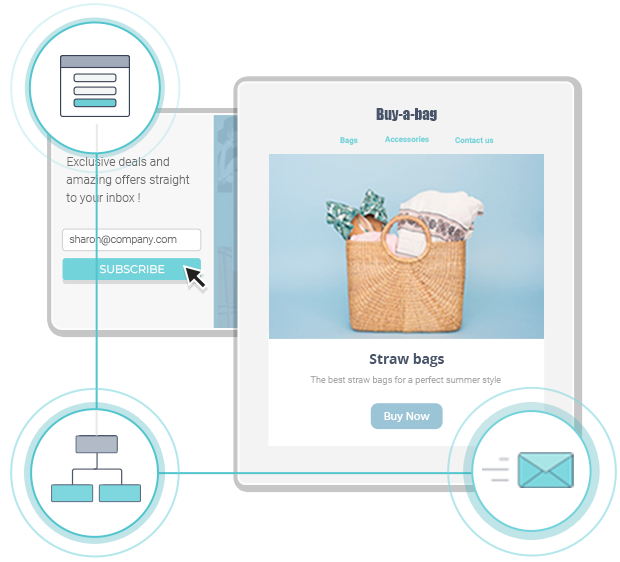
The easiest and most affordable email marketing and newsletter software!
What Is A Marketing Technique?
A marketing technique is a promotional tactic businesses use to increase brand awareness, attract new prospects, and turn them into customers. They enable marketers and business owners to build long-lasting relationships with existing customers and reduce churn.
These techniques are components of your marketing strategy, the holistic plan to market your business effectively and keep it profitable. Marketers and business owners weigh different parameters, usually conducting a SWOT analysis to determine which tactics can be helpful to them.
For example, B2B relies on inbound marketing tactics to flourish and get as many qualified leads as possible. At the same time, in B2C, especially in local businesses, low-budget solutions such as content creation and social media communications are more suitable.
19 Most Effective Marketing Techniques For Thriving Businesses
Let’s explore which marketing techniques will help you boost your conversion rates and sales:
1. Email Marketing
Email marketing is one of the most effective marketing techniques businesses rely on, with an average ROI of $42 for every dollar spent. According to recent data, daily email users will reach up to 4.6 billion by 2025, meaning that many of your customers and prospects spend valuable time there.
Email marketing lets you automate messages and send personalized emails to move subscribers down the funnel. To streamline your email marketing efforts, you need an email marketing service like Moosend or Mailchimp with compelling features, such as ready-made templates and email list segmentation.
Thankfully, there are tons of platforms for different budgets and needs. Check their pricing plans and capabilities carefully to make the best decision.
Email Types
Now, let’s introduce some main email types:
- Promotional campaigns: Emails informing customers about your offers to maximize sales.
- Transactional emails: These automated emails are triggered after specific transactions, e.g., a purchase.
- Welcome emails: The emails customers receive when they first sign-up on your list.
- Re-engagement campaigns: A series of emails to nurture inactive subscribers and win them back.
- Abandoned cart emails: Email reminders to purchase items left on the customer’s cart – look at the example by Vacation below:
Subject line: Ready to buy Vacation®? Complete your order now
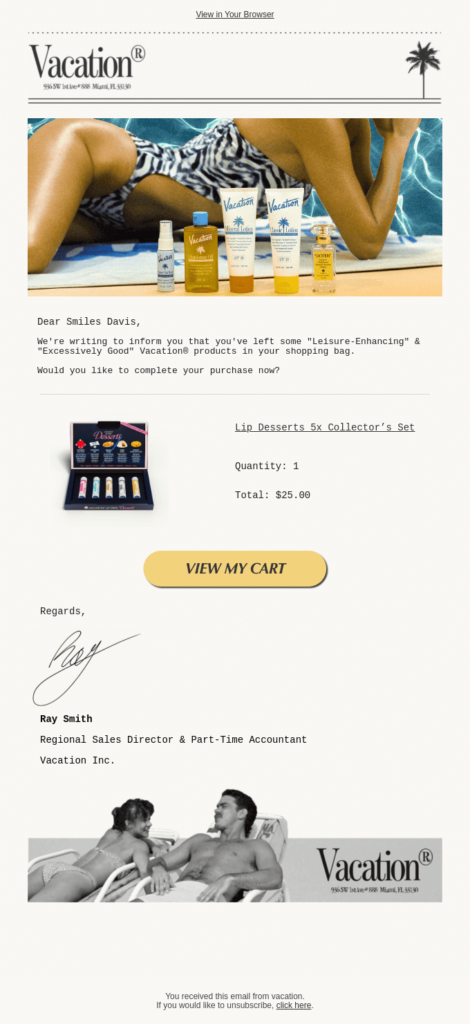
Ready to step into the email marketing world? Sign up for a Moosend account and explore our fantastic marketing automation features. Build unique campaigns in no time using our premade templates and craft automated sequences to save time!
2. Content Marketing
Creating content helps businesses nurture their audience at different funnel stages by educating and prompting them to take action. According to recent content marketing stats, 97% of respondents stated that content marketing is essential to their marketing strategy, confirming Bill Gates’ statement that “Content is King.”
What are the most prominent benefits of content marketing?
- It helps build relationships with customers and prospects.
- It drives demand in your niche market.
- It raises brand awareness and converts leads into customers.

An effective content strategy starts by identifying your customer personas and their needs to deliver great resources to them. You can host several content types on your website and share your content on other marketing channels like social media or email.
Top Content Marketing Types
Let’s see some of the most shared content types businesses craft for customers and prospects:
- Blog Posts: Tutorials or step-by-step guides covering topics relevant to your audience.
- Videos: Animated or live-action clips explaining a topic in a simple manner.
- Podcasts: Audio files, primarily available for download or streaming, usually in the form of a series.
- Infographics: A combination of copy and visuals for a specific topic.
- Reviews: Case studies or collection of testimonies emphasizing the benefits of your brand.
- White papers: An in-depth report about a relevant topic, similar to an e-book.
Thankfully, there are many tools to help you with your content creation process, paid or free. For example, you need a content management system like WordPress to succeed in blogging. At the same time, for visuals and infographics, you can use simple tools like Canva or Visme.
However, to place your content high on search engine rankings, you need the ultimate inbound marketing tool – SEO.
3. Search Engine Optimization
Search engine optimization (SEO) is one of the most effective marketing strategies. It’s a set of rules to follow that help boost your website content higher on search engine results.
In short, SEO can bring more potential customers to your website/blog and it’s an easy-to-analyze and improve method. Moreover, it’s a low-cost marketing technique that can boost your ROI in the long run.
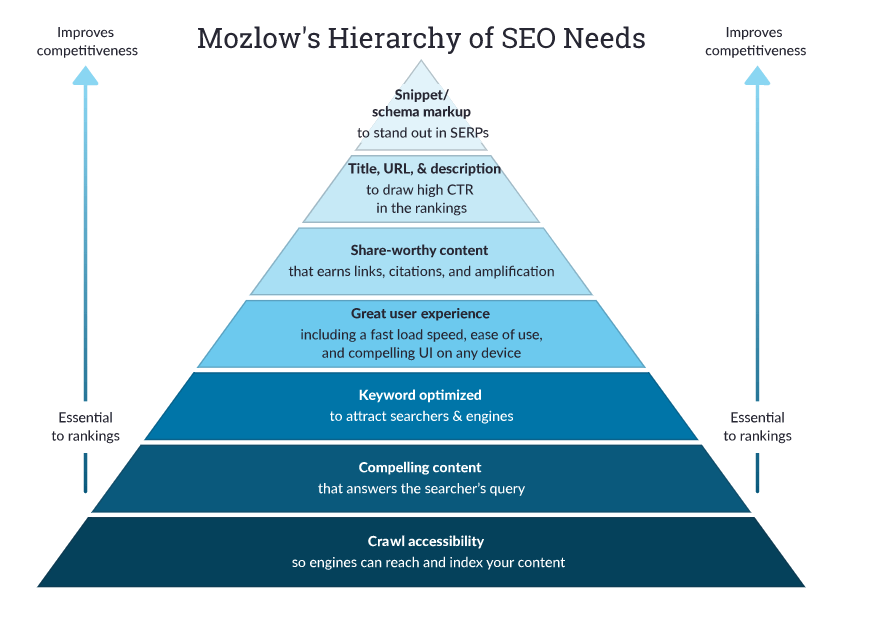
Here are the essential SEO optimization tactics businesses should go for:
- Research trending topics in your niche market and find relevant keywords.
- Sprinkle keywords inside your content, for instance, in titles and product descriptions.
- Optimize your website’s loading speed.
- Use alternative text for images.
Tools like Semrush, Ahrefs, and Ubersuggest will help you complete SEO optimization successfully. For example, let’s see what keywords appear for the term “scented candles:”
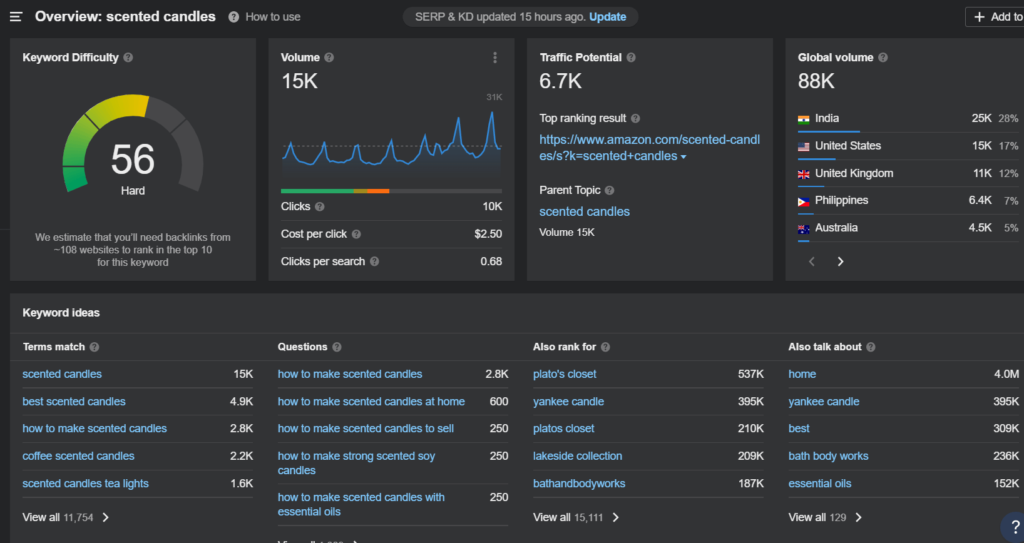
Remember that the prerequisite to ranking high is building great content that resonates with consumers interested in your products/services. Moreover, avoid overstuffing your content with keywords, as this will be a red flag for web crawlers.
Link Building
Link building is a complementary SEO method to drive website or blog traffic. When high authority sites link to your content, they help boost your search engine rankings. But how can you acquire those backlinks?
First, make sure that the content you create is worth linking to from notable websites. For example, you can follow the so-called skyscraper technique when it comes to blogging. Find the top blog post with high-quality backlinks and write a more enhanced version.
When you finish, you can plan an email outreach and contact websites linking to those resources to replace them with yours. Build emails with clever copy to show the value of your content and win over your target audience. You can streamline this process utilizing tools like Pitchbox.
Finally, you can also try guest posting, offering to write blog posts for other websites in your niche market with relevant topics. Thus, you can add backlinks of top-performing content pieces or blog posts you want to bring more website traffic to.
4. Social Media Marketing
Based on recent data, more than 53% of the world’s population is on social media.
Consumers increasingly tend to use social media platforms like Instagram, Facebook, or LinkedIn to make purchase decisions.
Hence, social media marketing is essential to a successful digital marketing strategy and a great place to attract new buyers. You can share updates about your new product/services or post engaging content that will delight your followers, as Nike did recently portraying the legendary tennis player Rafa Nadal:
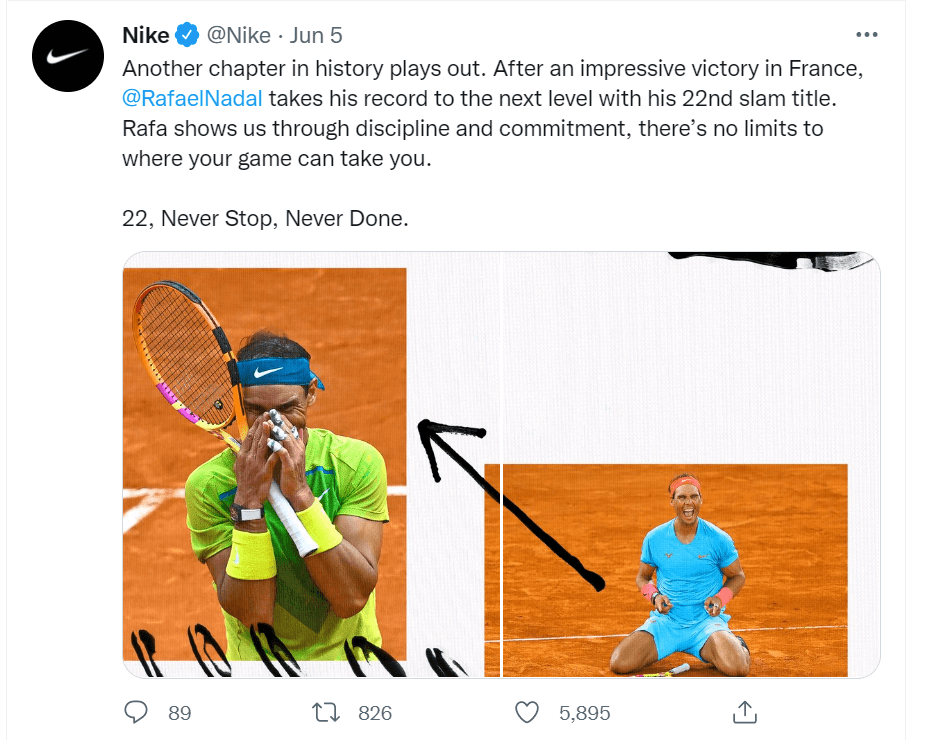
To build an effective social media marketing strategy, you first need to figure out which platforms are more popular for your buyer personas. For example, TikTok is very hyped among younger audiences, while Facebook is suitable for all age groups.
Once you’ve determined your target market, it’s time you set some SMART goals. You can experiment with diverse types of marketing content and topics to find what works best for your audience. Pay close attention to metrics such as:
- Impressions
- CTR
- Followers
- Engagement (Shares, likes, and comments)
Monitoring this data will enable you to optimize your social media marketing plan over time to bring the best possible results. But is organic traffic just enough? Find out the perks of social media ads in the next section.
Looking for detailed information about different social media platforms? Check our guides below:
5. Paid Ads
Even though the perks of maximizing organic traffic to your website are numerous, you can’t guarantee that visitors will ultimately convert. To ensure success, you need a more powerful weapon to help you reach your target audience faster – paid marketing!
One of the most popular online adverting models is PPC, standing for Pay-Per-Click. A business pays a predetermined amount for every click this ad receives. There is also CPM (Cost Per Impression), where companies pay for every thousand impressions they get.
Let’s see the most popular paid advertising types:
SEM
Search Engine Marketing (SEM) makes your ads appear at the top of search engine results to bring more qualified leads to your websites. For example, let’s have a look at the results that show for the query “applicant tracking system” on Google:
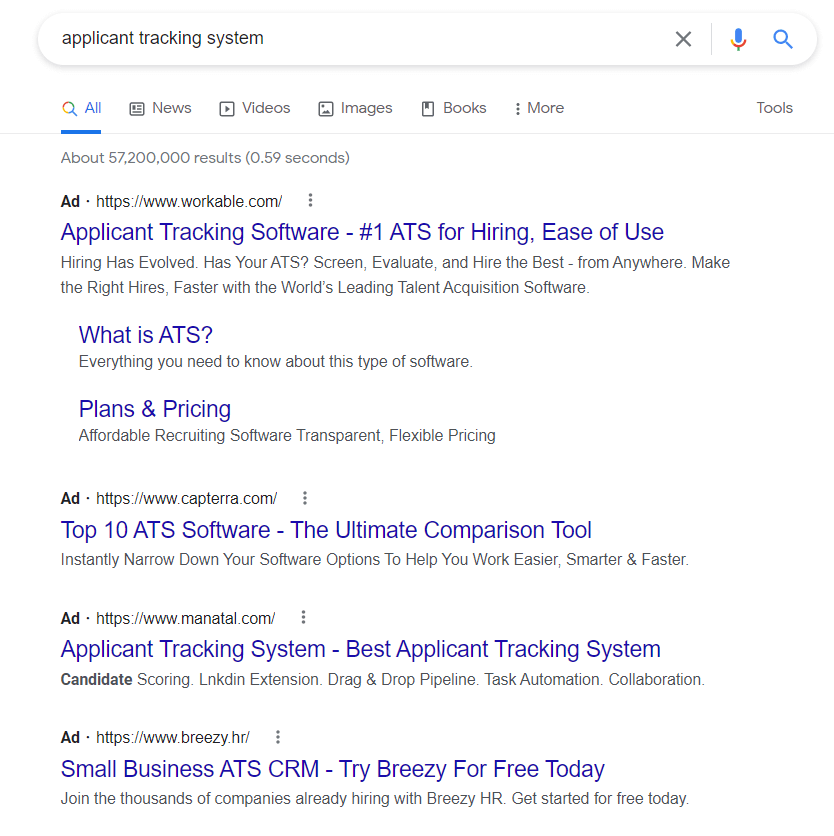
Considering that users are more likely to click on the top results, this can result in an abundance of leads that are highly converting.
Display Ads
These visual ads appear on other websites and help businesses nurture their audience while browsing the web. These ads are often used for retargeting, bringing users that have already interacted with your brand at least once.
Here’s a display banner by Moosend with a beautiful GIF to attract viewers:
![]()
Social Media Ads
You can also run paid ads on social media to reach more interested buyers. For instance, Facebook is very popular with ads, as it lets you narrow down to important criteria such as demographics, interests, and preferences.
Make sure to choose the social media your customers and prospects visit the most. Then follow the rules of each platform to create unique ads.
But what makes a successful ad? In brief, you need a CTA with clever copy that resonates with your audience, combined with a striking visual.
6. Referral Marketing
Have you ever heard about the importance of word-of-mouth marketing? No one can promote your business better than your existing customers. They can vividly describe to friends and family what they love about your products/services and convince them to trust you, too.
A referral marketing plan aims to incentivize customers to refer your business to their peers. Those incentives should be attractive enough to prompt your customers to take action. For instance, it can be a discount coupon or a monetary reward for every new buyer you gain.
So how can you promote your referral programs? You can share your referral initiatives on social media or create dedicated email campaigns, as Treehouse did:
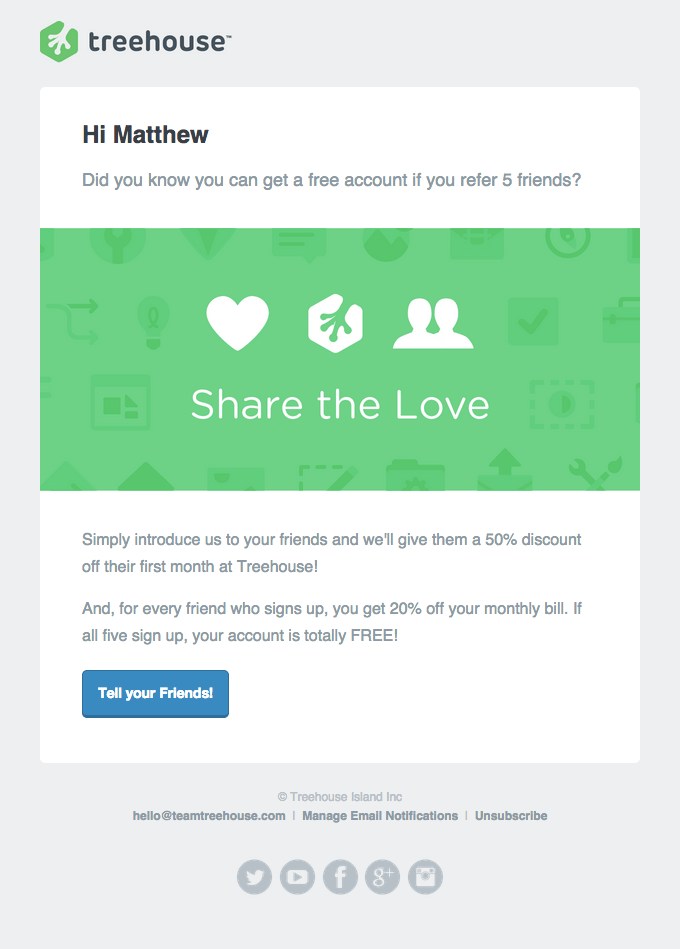
You can also add a referral button at a prominent place on your website or email footer. Spread the word far and wide!
7. Conversational Marketing
In the era of online marketing, it’s important to remember that customer relationships matter. Maintaining a dialogue-driven approach when interacting with buyers, prospects, and partners is key for brands that want to go big.
That’s what conversational marketing is all about. Motivate consumers to reach out through chatting platforms like Messenger and reply to DMs to make your communications more personal.
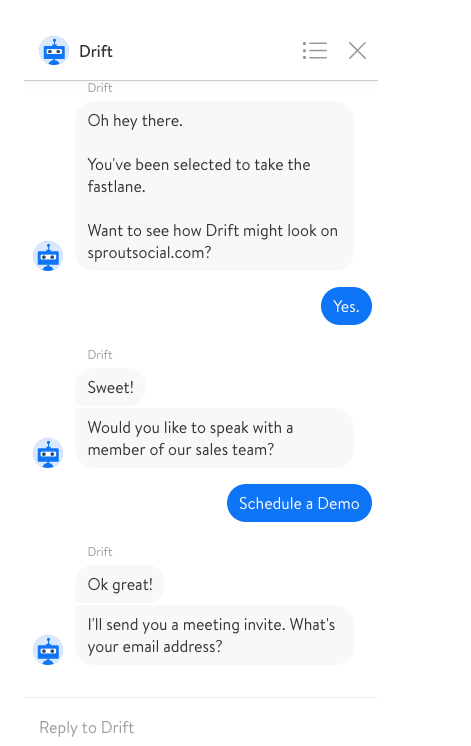
If paying close attention to those platforms on a regular basis feels challenging, you can also utilize chatbots to automate some of those replies. However, keep in mind that specific customers will want to bypass the AI component to have a chat with you asap. And it’s worth giving them that option, too.
8. Networking
If you ever get the opportunity to network with people in your niche market, always go for it! Networking helps businesses build solid relationships with existing or prospective partners or customers, resulting in mutual benefit.
Networking can happen both online and offline. Online networking usually takes place on social media and can be game-changing for your business. Follow people and companies you admire and start chatting with them over a subject that matters to you.
These conversations can be the first touchpoint of an ongoing partnership or may inspire you to pivot your own work. You can also follow social networks in your niche market to exchange valuable ideas with your peers.
As for offline marketing, it usually happens during events and conferences and can significantly impact your work. Get your business card ready, practice your firm handshake, and introduce yourselves to top professionals in your field.
9. Webinar Marketing
If you want to position yourself as a leader in your market, hosting webinars is one of the best ways to achieve this. The popularity of webinars has risen since the pandemic struck, and many businesses prefer them over traditional events as they’re cheaper.
This marketing technique is especially effective for e-commerce B2B organizations, as they give an excellent opportunity to educate customers and prospects on challenging topics and show them how your products/services can be of great value to them.
And there’s more than that; webinars can also work as lead magnets, supporting your email list-building efforts. Craft a strong invitation followed by a beautiful landing page and invite prospects and customers with a high interest in the topic to convert.
Here’s the social media post for one of our webinars:

You can promote your webinars via email and social media and consider offering an incentive, such as a prize to make participation more appealing!
10. Cross-selling/Up-selling
Knowing your customers’ purchase history will help you craft suitable marketing campaigns for them. Cross-selling and up-selling initiatives can boost your sales massively, so you’d better include them in your marketing strategy.
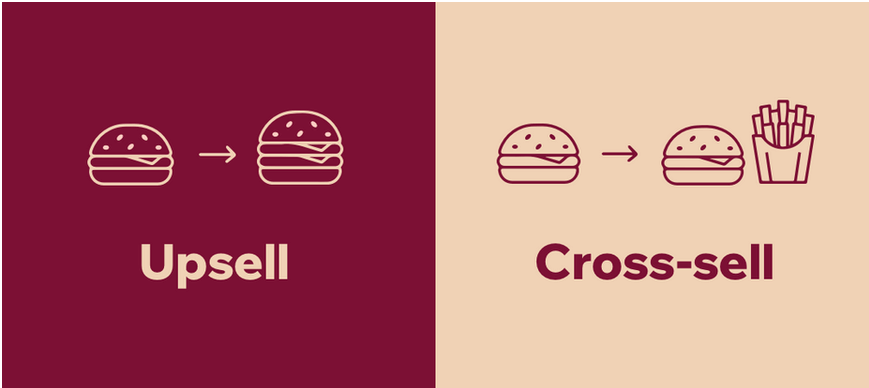
To promote the right products to the right customers, dive into the buyer’s journey to understand their needs and intents at each step. CMS platforms like Salesforce and Hubspot will enable you to keep customer data in one place to determine what’s best for them – is it a complementary product or an upgrade?
To succeed in cross-selling and up-selling, you need to combine forces with your customer education team and sales reps, who consistently collect feedback from customers and prospects. Thus, you’ll determine their needs and which of your products/services can be valuable to them.
11. Offline Marketing
Even though online marketing tools have gained solid ground over the years as the Internet conquered the world, traditional marketing techniques are still effective in this digital era.
Here are some offline marketing types:
- TV ads
- Billboard ads
- Posters
- On-site events
These techniques are still relevant, especially for B2C companies with a broad target audience and a large budget available. Here’s a successful ad for toothpaste “Formula,” with an amazing visual and captivating copy.

If you’re still on a tight budget, you can print beautiful branded flyers in a standard flyer size, especially if you have a physical store and want to invite local people over. And of course, you can hand out business cards to your network to enhance your brand visibility.
12. Direct Sales
Direct selling is another traditional marketing technique which is the primary marketing and selling technique for businesses such as AVON and Herbalife.
As the name suggests, sales reps and marketers build a customer base utilizing face-to-face communications. For example, door-to-door sales belong in this category, even though it’s not the most optimal method to practice. But with great networking, you can mimic the door-to-door method and bring the best possible results.
To succeed in direct sales, a professional should be able to persuade others fast to meet their objectives. As in direct sales, mastering persuasion is at the core of marketing communications, even when it’s not a standalone practice.
13. Earned Media
As mentioned earlier, word-of-mouth is a crucial marketing component, and marketers should always strive for it. You can gain publicity and exposure without paying for it when you deliver great content to customers and establish a strong SEO presence.
So when other businesses and customers share your resources, such as blog posts or infographics, they bring you organic traffic and display your brand assets to their own followers. This can have a great impact going forward, as they show that you are a leader in your field and that consumers should put you on their radar.
Finally, you can obtain paid media from publishers and influencers with a large audience and a strong influence in your niche market to meet your promotional goals faster if you wish.
14. Influencer Marketing
Influencer marketing is becoming stronger and stronger every year, as the below graph shows. Businesses partner with influencers with a strong following on social media to demonstrate their products/ services to them.
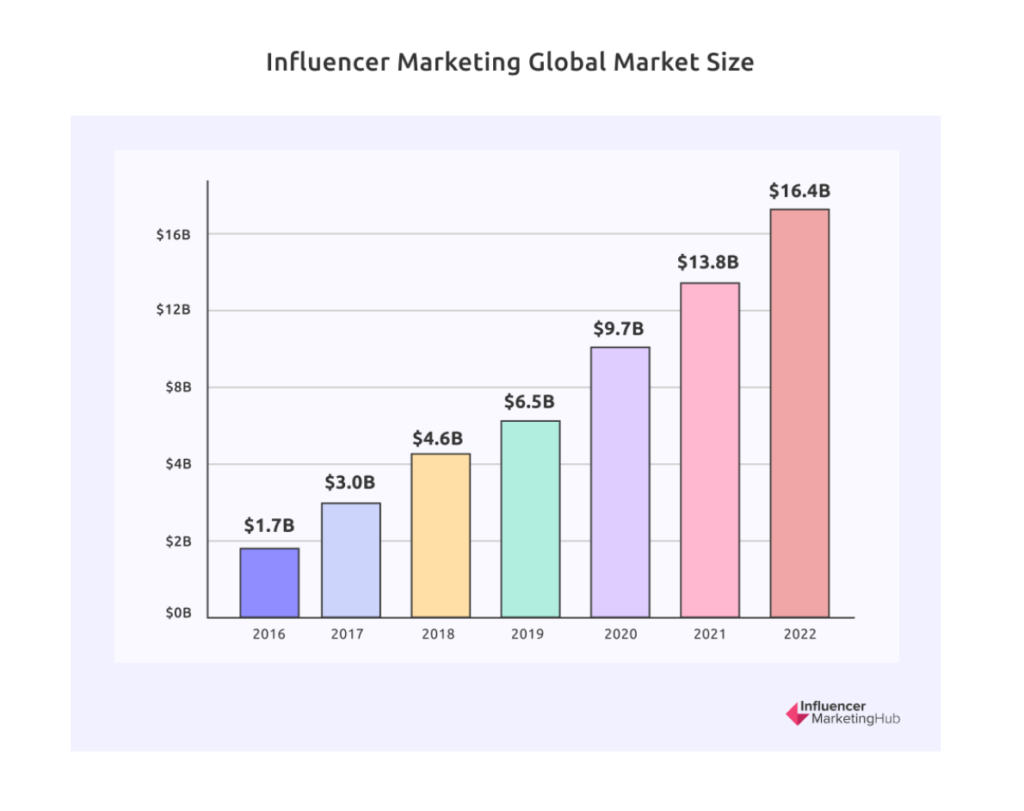
This form of digital marketing uses the impact of social proof. To succeed in this marketing technique, you should choose the influencers you partner with carefully as they turn into ambassadors of your brand.
So before reaching out to these individuals, choose which social media platform is best to showcase your brand and ensure that the influencer’s followers are compatible with your target audience. Then, sit down to decide how to promote your brand’s product/services to gain new customers.
15. Guerilla Marketing
Guerilla marketing is undoubtedly one of the most creative ways to market your business. It’s an innovative promotional idea aiming to attract an audience in an unconventional and surprising style.
Let’s see some of the most common guerilla marketing types:
- Street marketing – marketing activities taking place outdoors, putting elements of the street in the game.
- Ambient marketing – promoting a product by interfering with the regular flow of things.
- Ambush marketing – promoting products/services during a competitive event to take advantage of their audience.
And now, let’s move to a successful guerilla marketing example by Labello lip balm:

They added kissing point stickers to public train stations to support those who want to kiss their loved ones goodbye. What a beautiful initiative!
16. User-Generated Content
We’ve already elaborated on the power of social media and word-of-mouth marketing. User-generated content combines both of them; your customers act as ambassadors by sharing content demonstrating your brand assets to their families and friends.
But how can you motivate your customers to post content that will bring more eyes to you?
- Adopt a hashtag strategy
- Run giveaways and contests
- Offer incentives and rewards
If you to want boost user-generated content, the first step is to define which social media platform is the best for the campaign you plan and which content will work best for your initiative. Then set a goal for your content strategy and get your customers on board!
Let’s see an amazing example by Starbucks on Instagram:
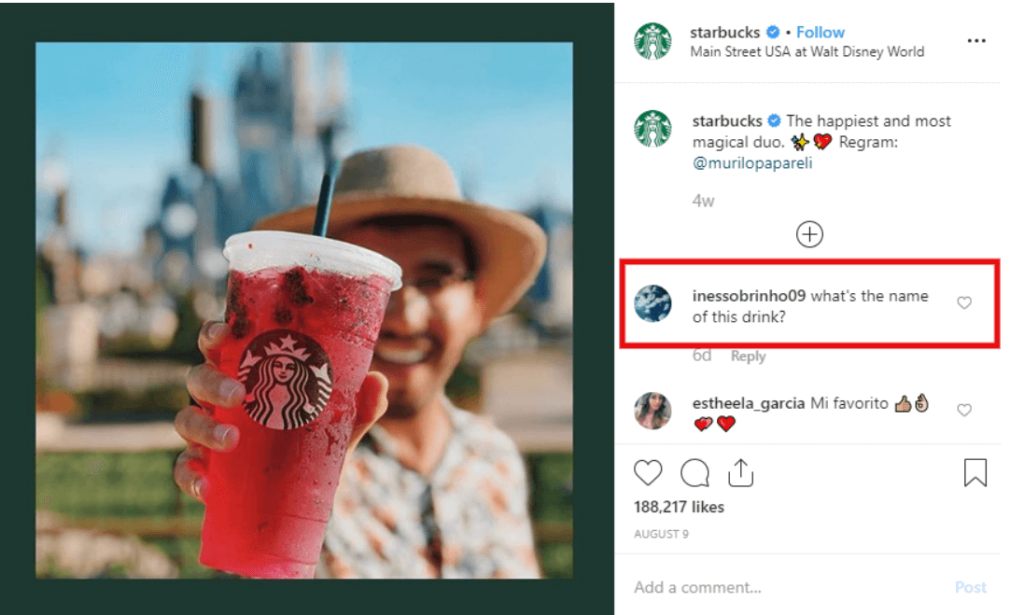
17. Cause-Related Marketing
If you want to combine business with a great purpose, then cause-related marketing should be your go-to marketing technique. It’s the collaboration between for-profit and non-profit organizations for mutual benefit.
Nowadays, consumers think more about which brands to support and seem to favor businesses serving corporate social responsibility (CSR) initiatives. That’s why building a cause-related marketing strategy will help you attract a new audience, as long as your practices are proactive and not performative.
For example, Yoplait run “Save Lids to Save Lives” – customers were encouraged to collect pink lids from their cartons and mail them to save 10 pounds for each to fight against breast cancer. Overall, Yoplait has donated over $15 million for this significant cause.
So find a relevant cause to dedicate your business to and invite your customers to participate, if possible!
18. Affiliate Marketing
Affiliate marketing is a sales model offering commissions to companies or individuals to promote your products to their own audiences. They act as brand representatives and get a great source of passive income.
So what are the top affiliate marketing benefits? Let’s see:
- It increases your sales and ROI
- It boosts brand awareness
- It creates a network of trusted partners
To claim these advantages for your own business, you need to set up an affiliate program specifying the commission type and rate. Plus, offer guidelines on how they can successfully approach potential customers to maximize their income.
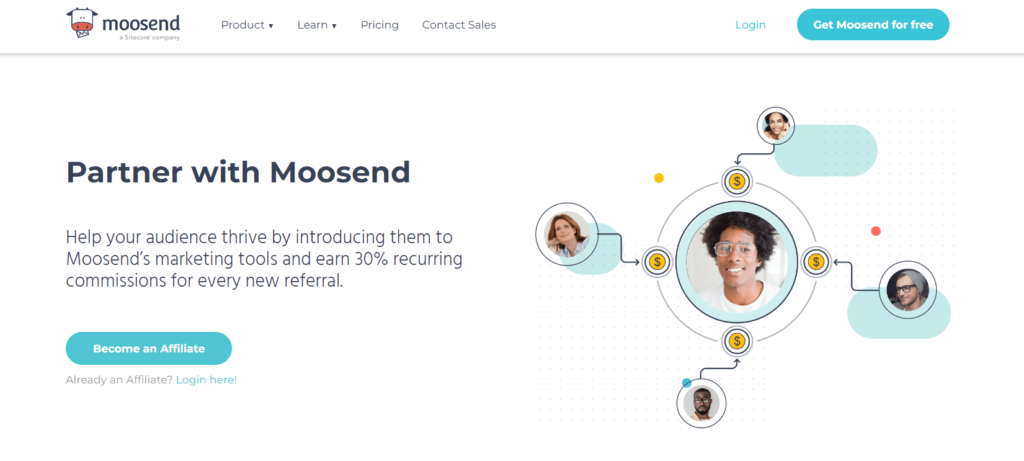
Did you know that Moosend has one of the most successful affiliate programs in the field? Check it out if you feel that it’s relevant to you.
19. Brand Storytelling
For last, we saved brand storytelling, an important component of all marketing communications. It’s the narrative businesses use to evoke emotions and show customers and prospects their brand values and intents.
Your brand story should be easy to digest and hard to forget. It’s vital to share it consistently with customers, considering what they’d like to know about your “behind the scenes.”
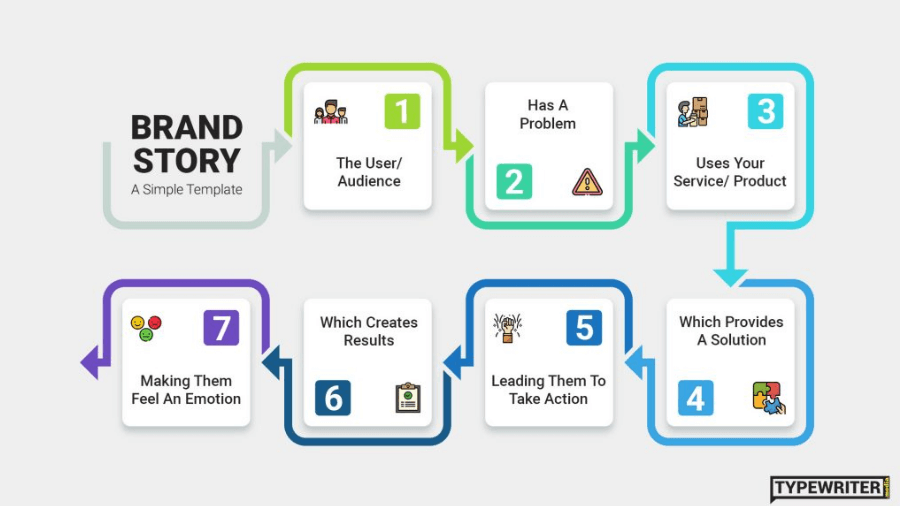
As Ann Handley once wisely said, you should “make your customers the hero of your stories.” This is a great storytelling approach that will put the customer at the center of attention.
How To Develop Your Marketing Technique
After you’ve chosen the best marketing techniques for your business, it’s time you set it in motion. Here is a quick round of tips to make it happen:
- Define your target audience to determine customer needs and pain points.
- Set your objectives following the SMART framework to bring the best results possible.
- Analyze how each marketing technique performs to improve it if needed.
- Keep a consistent brand voice that moves customers and motivates them to stay around.
- Send personalized messages to customers by means of marketing automation to seal the deal.
- Focus on community building and make your customers feel valued and included.
Follow these tips and get ready to rock!
The Takeaways
Thankfully, there are a plethora of marketing techniques to promote your business for every budget. Explore the best for your target audience and experiment with different tactics and content.
As with every other business tactic, there will be a trial and error phase. Monitor the performance of your chosen techniques and see how you can elevate them to boost brand awareness and ROI!
Are you ready to build your first email campaigns, and send personalized messages to customers to move them down the funnel? Sign up for a Moosend account today and try our top-notch features!
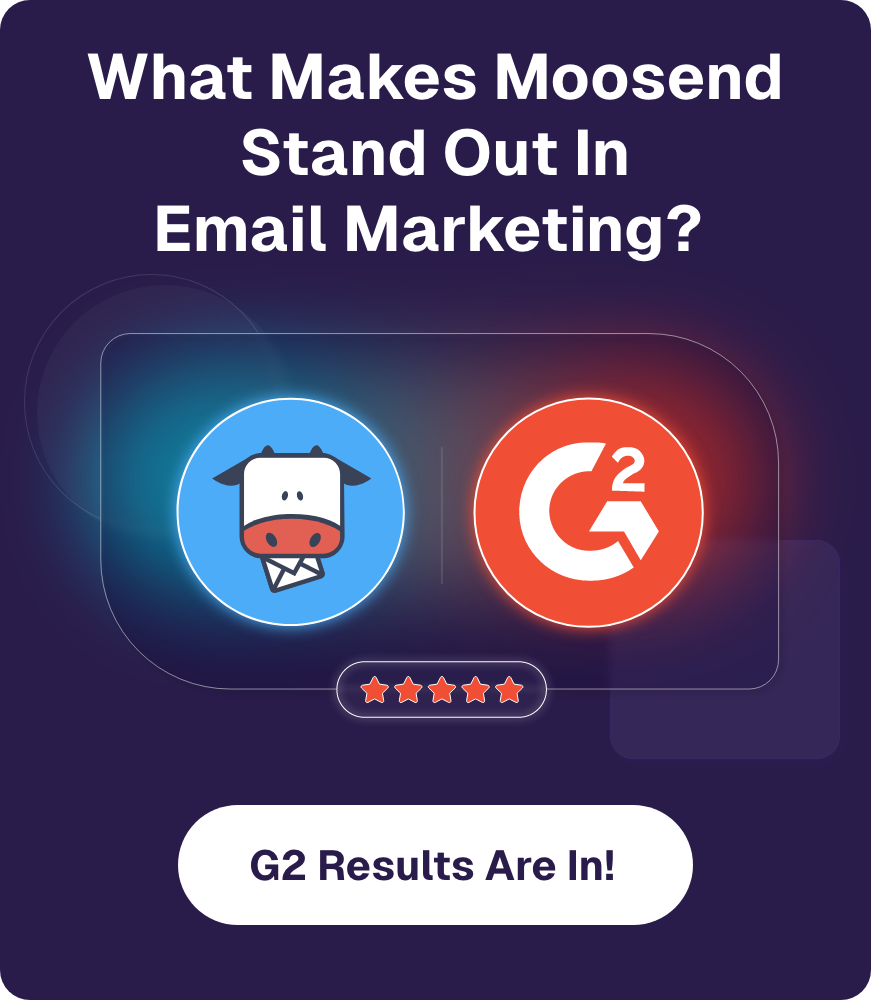

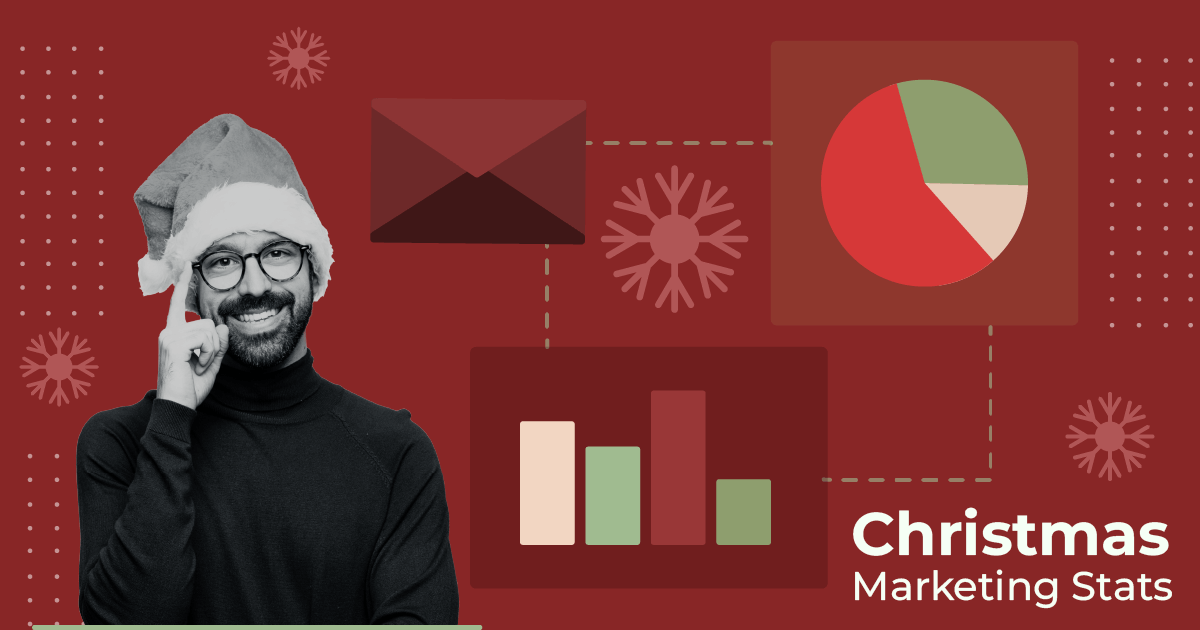

 Published by
Published by
